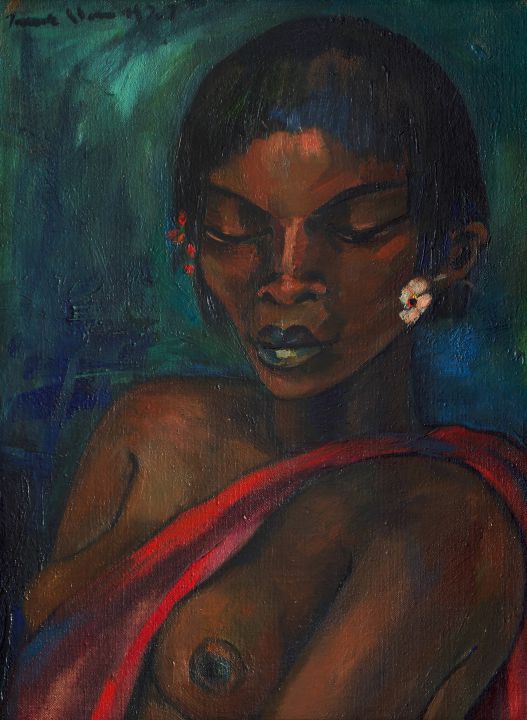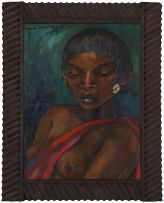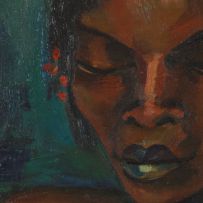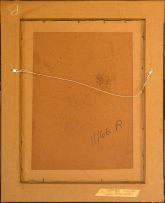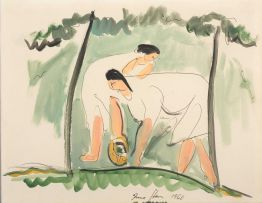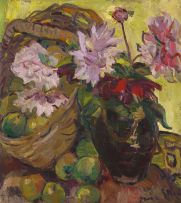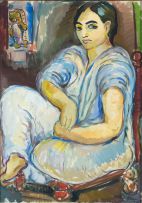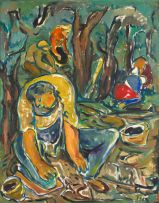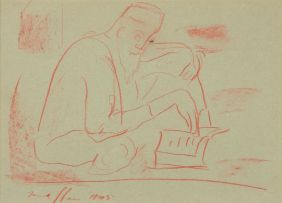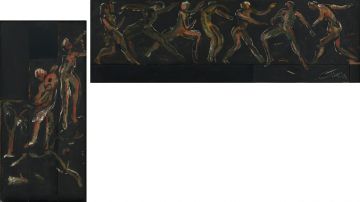Modern, Post-War and Contemporary Art, Decorative Arts, Jewellery and Fine Wine
Live Virtual Auction, 8 - 11 November 2020
The Tasso Foundation Collection
Incl. Buyer's Premium & VAT
About this Item
signed and dated 1927
Notes
The late 1920s marks a significant period in both Irma Stern's personal and professional life that saw her international career flourish alongside the growing European appetite for exotic images of Africa. Returning from a trip to Europe, where she exhibited in Germany and France, winning the Prix d'Honneur at the Exposition Internationale des Beaux-Arts in Bordeaux, Stern would purchase The Firs in her own name in 1927, before travelling for a third and final time to Swaziland at the end of the year.1
Here, she would confront the loneliness inherent in the unrequited love that accompanied her marriage to her former tutor, Johannes Prinz, the year before. Estranged by the beginning of the 1930s, their union would dissolve soon after. As a testament to their inability to find any meaningful connection, Stern appears in her diaries and letters most happy when she was away, painting. Her work from this time thus reveals an emotional complexity in which Stern's individual portraits are charged with a certain romantic inflection, underscored by her own private turbulence.
This portrait of a Swazi Woman was presumably executed in the region of the Ezulwini Valley where Stern stayed during October and November of 1927. During this visit she was invited by the Swazi King, Sobhuza II to attend a traditional dance at the Royal Kraal in Ludzidzini, some 10 kilometres away from where she was staying.2 The sitter in the present lot was presumably encountered during these festivities, possibly an Umchwasho, which is a customary chastity right in which young woman are separated into various age regiments indicated by their varying dress codes as they ready for marriage.3 Whilst similar figures populate her larger group portraits of Swazi women from 1927 such as Daydreaming and Repose, in these instances form is favoured over individuality, with subjects becoming more a stylised part of the pictorial construction.
In the present lot, we see both Stern and her subject coming of age. As she would grapple with the complicated relationship that exists between a painter and the sitter, Stern is seen here establishing the foundations of the psychologically nuanced vocabulary that would define her later portraits. By rendering the eyes of her subject closed, Stern creates the speculative distance of a hermetic world into which we are not invited. The enigma of this dramatically lit portrait has its biographical counterpart that can be found in a letter penned shortly before the end of her trip where Stern confesses a mysterious, unnamed infatuation. Like the private, contained world of her Swazi sitter, Stern briefly offers us a rare glimpse into her own romantic preoccupations as she writes:
'… and I am in love … just imagine. I would have never thought that I would fall in love again. Love is certainly something outside one's control. There one is - an honourable and respectable married woman - with little pleasure from things like love and suddenly one looks away - one becomes young again and Bang! one lands in the middle of it all. How long this is going to last I do not know and do not care. It is almost like being situated between the past and future … it is wonderful nevertheless - even if it is only the harmony of a single day - it carries endless meaning for me - the consciousness of another person in my loneliness …'4
- Marion Arnold (1995) Irma Stern: A Feast for the Eye, Vlaeberg: Fernwood, page 19.
- Clive Kellner (2012) Representations of the Black Subject in Irma Stern's African Periods: Swaziland, Zanzibar and Congo 1922-1955. University of Cape Town, unpublished MA dissertation, page 31.
- Ibid.
- Irma Stern, quoted in Neville Dubow (1991) Paradise: The Journal and Letters (1917-1933) of Irma Stern, Cape Town: Chameleon, page 93.
Provenance
Stephan Welz & Co in association with Sotheby's, Cape Town, 9 February 1999, lot 245, with the title Congolese Girl.
The Tasso Foundation Collection of Important South African Art assembled by the Late Giulio Bertrand of Morgenster Estate.
